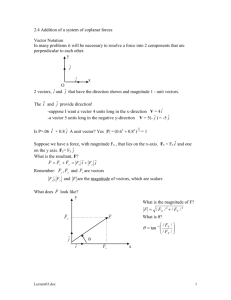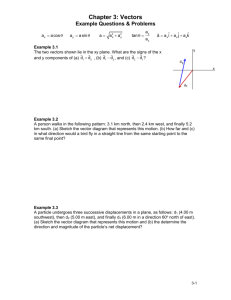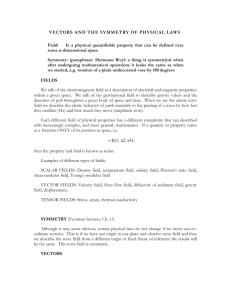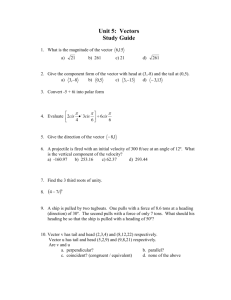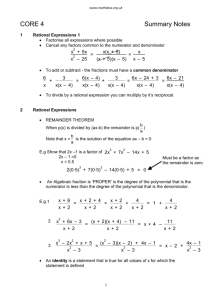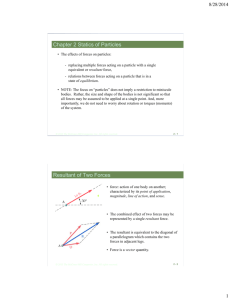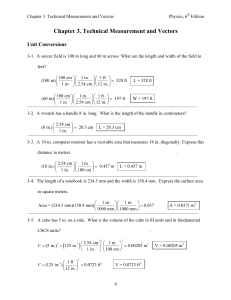Physics 8A Vectors and Static Equilibrium Background We have
advertisement
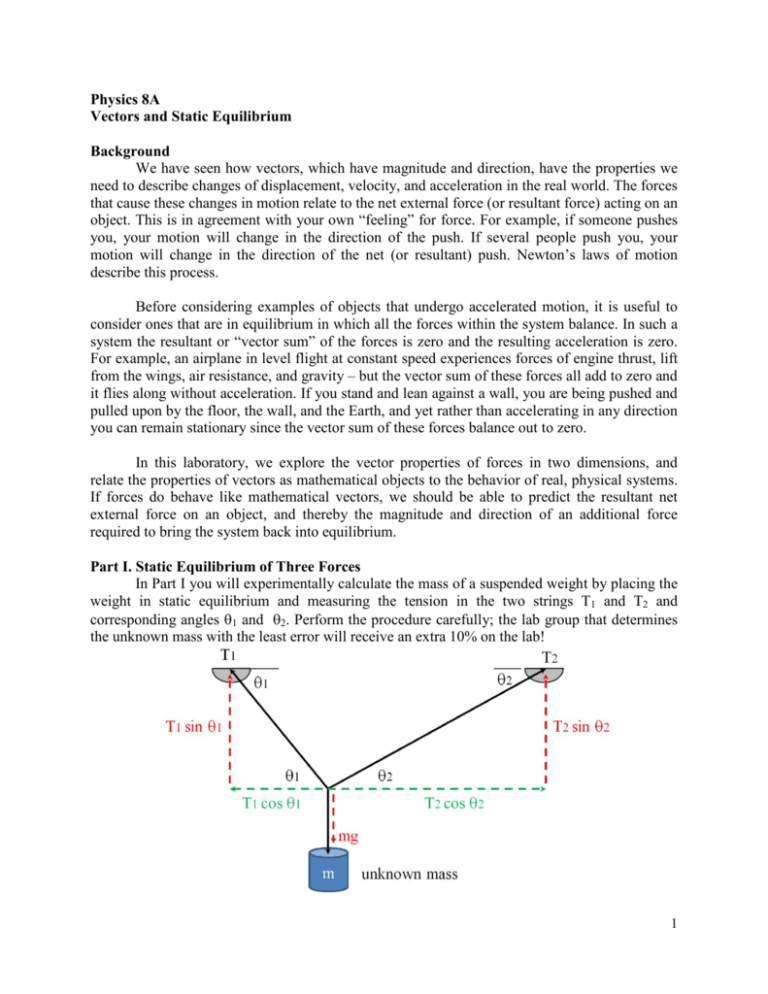
Physics 8A Vectors and Static Equilibrium Background We have seen how vectors, which have magnitude and direction, have the properties we need to describe changes of displacement, velocity, and acceleration in the real world. The forces that cause these changes in motion relate to the net external force (or resultant force) acting on an object. This is in agreement with your own “feeling” for force. For example, if someone pushes you, your motion will change in the direction of the push. If several people push you, your motion will change in the direction of the net (or resultant) push. Newton’s laws of motion describe this process. Before considering examples of objects that undergo accelerated motion, it is useful to consider ones that are in equilibrium in which all the forces within the system balance. In such a system the resultant or “vector sum” of the forces is zero and the resulting acceleration is zero. For example, an airplane in level flight at constant speed experiences forces of engine thrust, lift from the wings, air resistance, and gravity – but the vector sum of these forces all add to zero and it flies along without acceleration. If you stand and lean against a wall, you are being pushed and pulled upon by the floor, the wall, and the Earth, and yet rather than accelerating in any direction you can remain stationary since the vector sum of these forces balance out to zero. In this laboratory, we explore the vector properties of forces in two dimensions, and relate the properties of vectors as mathematical objects to the behavior of real, physical systems. If forces do behave like mathematical vectors, we should be able to predict the resultant net external force on an object, and thereby the magnitude and direction of an additional force required to bring the system back into equilibrium. Part I. Static Equilibrium of Three Forces In Part I you will experimentally calculate the mass of a suspended weight by placing the weight in static equilibrium and measuring the tension in the two strings T1 and T2 and corresponding angles θ1 and θ2. Perform the procedure carefully; the lab group that determines the unknown mass with the least error will receive an extra 10% on the lab! 1 The following force relations can be used to determine m: -T1 cos θ1 + T2 cos θ2 = 0 (equation 1) T1 sin θ1 + T2 sin θ2 – mg = 0 (equation 2) Clamp two rods (90 cm long) vertically to the table, approximately 80 cm apart. Attach the non-concurrent force apparatus (steel beam with attached protractors) to a cross rod, and clamp this rod between the vertical rods (but don’t attach the mass yet). Add a force transducer to one of the strings near the protractor. Set up LabPro as we have done previously, but this time connect a force transducer to a digital port (DIG/SONIC) on the LabPro. Start the Logger-Pro program. If everything is set up correctly, the tension in the string should be displayed. Hang the unknown mass and measure T1, θ1, and θ2. Use equations 1 and 2 to determine mass m. Repeat this procedure for 3 additional configurations in order to obtain a larger statistical sample from which to determine the mass. Record your three measurements of mass m. At no time should you hang the unknown mass vertically from the force transducer. Doing so is a violation and will disqualify your group from earning extra credit!! Part II. The Force Table In Part II you will construct a “force table” from your lab bench in order to further refine your measurement of the unknown mass. You will need to use three pulleys to balance the three forces as shown below. 2 Hang your masses on three strings and run the strings over three pulleys. Position two protractors directly beneath the connection point (knot) of the three strings (it should always remain directly below the connection point). Adjust the angles and masses M1, M2, M3 (unknown mass) until the three forces balance. You should have 3 pulleys mounted around the lab bench; these can be moved to almost any angle around the bench (as measured from a chosen “0 degrees” position). Each pulley's string is tied at one end to a knot above the center of the protractors. The other end of the string can be loaded with masses, whose gravity provides a force vector pulling on the knot. The goal is to adjust the masses and angles so that the knot is stationary and directly over the center of the protractors. The force of gravity on a mass m (in kg) is measured in Newtons and its magnitude is given by F=mg, where g is the acceleration due to gravity. Using a full page of graph paper, carefully draw a scale diagram showing the vector sum of the three forces F1, F2, F3. Theoretically, these vectors should sum to zero and you should be able to determine the unknown mass. Add the x and y components of your three vectors F1, F2, and F3 to show that ∑Fx = 0 and ∑Fy = 0. F1, acts at an angle of θ1 F2, acts at an angle of θ2 F3, acts at an angle of θ3 All the angles are measured counterclockwise from the positive x-axis. If the net force on the object (the knot) is zero, then the x- and y-components of the three vectors must separately add up to zero: F1x + F2x + F3x = 0 F1y + F2y + F3y = 0 3 For a vector with magnitude F and direction θ, the components are: Fx = F cos θ Fy = F sin θ Hence we can write: F1 cos θ1 + F2 cos θ2 + F3 cos θ3 = 0 F1 sin θ1 + F2 sin θ2 + F3 sin θ3 = 0 Or: M1g cos θ1 + M2g cos θ2 + M3g cos θ3 = 0 M1g sin θ1 + M2g sin θ2 + M3g sin θ3 = 0 Solve either (or both!) of these equations for M3. Record your final “best-guess” and provide it to your instructor for comparison to the known value of M3. Write a formal lab report and submit it 2 weeks after the date of the lab. Measure carefully. Good Luck! 4
